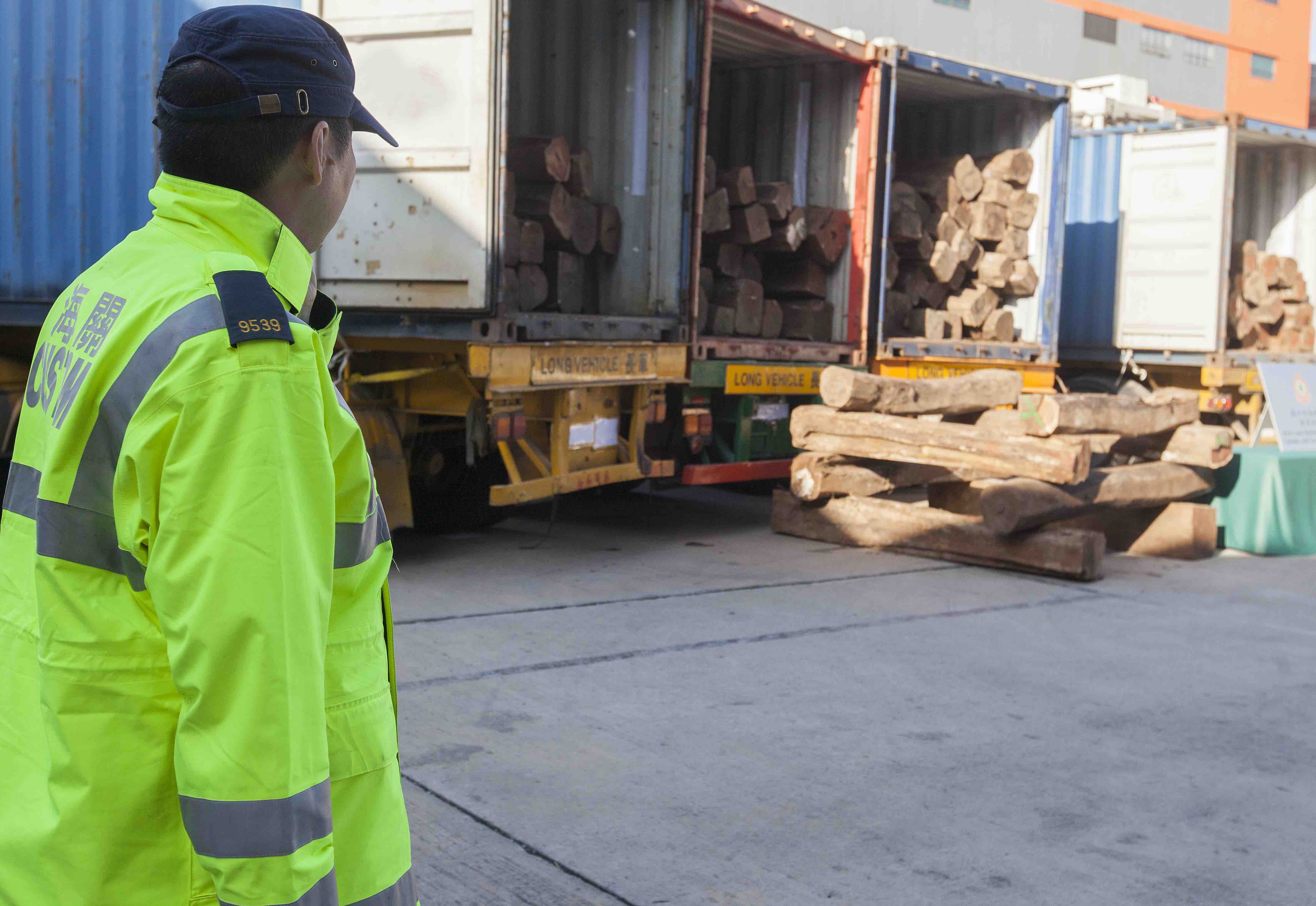Hong Kong has a timber-trafficking problem.
Held in 50 cargo containers at secure sites, a stockpile of more than 1,200 tons of seized tropical hardwood attests to the city’s role as a major conduit for timber smugglers en route to China.
And while its storage is causing severe financial implications for the city, its size has only continued to grow, as tropical forests around the world are logged to meet demand from the mainland’s multi-billion dollar luxury furniture industry.
So far this year, the Customs Department has intercepted four major shipments of rosewood — a label referring to a wide array of slow-growing, richly-hued hardwood species — and one massive load of red sandalwood, a timber so valuable it’s known as “red gold.”
The sheer amount of confiscated wood — both types are protected under the Convention on International Trade of Endangered Species (CITES) — set Hong Kong apart, said Dave Gehl, a program director at the Environmental Investigation Agency.
“We can’t think of too many other countries around the world that have seized as much rosewood as Hong Kong has,” said Gehl, discussing this year’s busts.
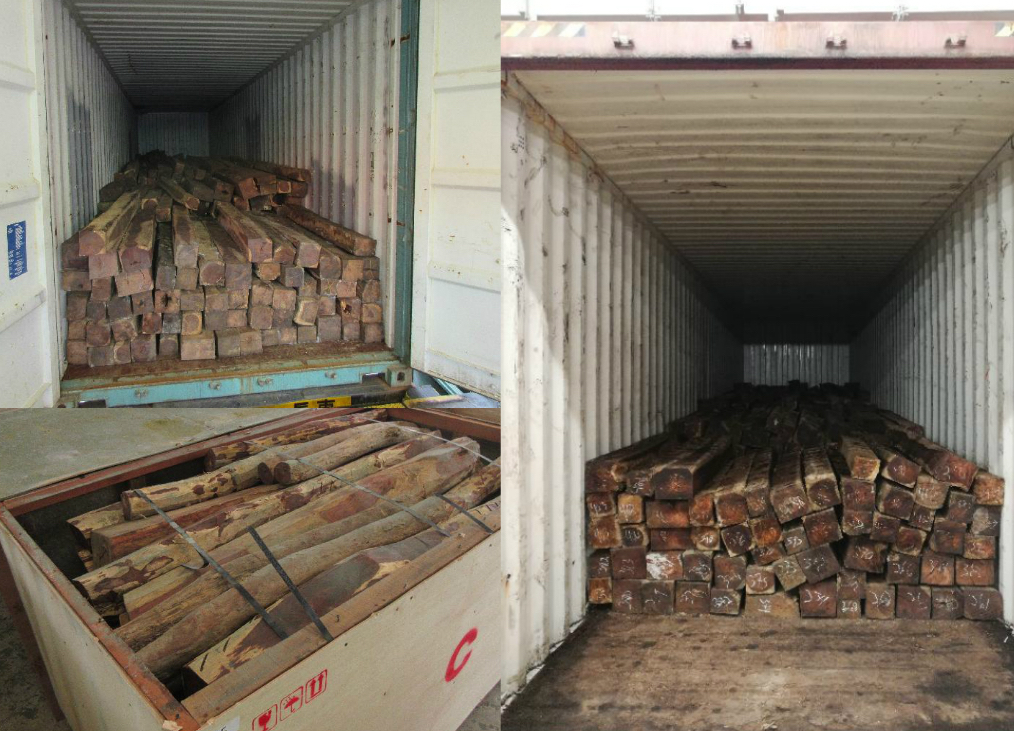
The seizures, the most recent just last week, already represent more than twice the amount captured in 2017, weigh some 118 tons, and are valued at HK$17 million (US$2.1 million).
The Agriculture, Fisheries and Conservation Department, responsible for following up on cases involving endangered species, expected as much.
In December, as it sought a recommendation from the Endangered Species Advisory Committee (ESAC) on how to dispose of its growing stockpile, the AFCD acknowledged that “rapidly rising demand” for precious tropical hardwoods had led to “serious concerns” about the unregulated and illegal timber trade.
In its submission to the committee, it wrote that while the department would “stay alert,” it expected “more timber seizures … in the future.”
Environmental groups, though, say more could be done to deter timber traffickers from turning the city’s free port — long known as a wildlife-smuggling hub — into what one report dubbed a “golden route” to China.
One major obstacle, say activists, is that trafficking in endangered species does not fall under the Organized and Serious Crimes Ordinance.
As such, instead of being handed to the police, cases fall to customs and the AFCD, which have more limited investigative powers and resources to combat what are often transnational syndicates responsible for the trade.
Another challenge is that punishments for CITES trafficking violations, despite recently being strengthened by the government, seem to provide little deterrence.
This is because prosecutions, if they do happen, overwhelmingly focus on mules, leaving the networks behind major shipments untouched, according to ADM Capital Foundation (ADMCF), which has reviewed more than 160 cases involved endangered plant and animal life.
A case in point is a record seizure in October 2015. The 1,000-ton haul of Malagasy rosewood, valued at HK$40 million (US$5 million) by customs, was found aboard a cargo vessel then named the Min Feng and bound for a Chinese state-owned company.
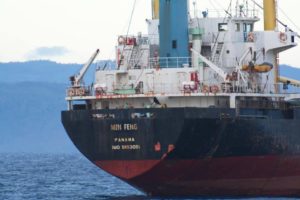
Several key details of the bust, including links to Hong Kong-registered shipping firms, have been published by Reuters, and additional information has been passed to Coconuts HK. No one, however, has been held accountable.
In a recent email to Coconuts HK, the ACFD declared that the case was closed, saying “no prosecution was initiated” as “the actual consignee could not be identified.”
Alex Hofford, a wildlife campaigner with WildAid Hong Kong, said that settling for another “wildlife crime cold case” was not good enough.
“The shocking fact that this case relating to a record seizure of a million kilos of rosewood has been shut without a single prosecution demonstrates exactly why Hong Kong’s Security Bureau needs to urgently place our endangered species law under the Organized and Serious Crimes Ordinance,” he told Coconuts HK.
“Wildlife crime is the third-largest transnational organized crime after human and dangerous drugs smuggling, so it’s time the Hong Kong government took the matter seriously.”
Click on the story map below to see the route used for 2015’s record rosewood seizure and learn more about the city’s role in illegal timber trafficking (full screen Story Map here)
China’s Hongmu industry and Hong Kong’s ‘Golden Route’
For more than a decade, environmentalists have recorded the devastation wrought on tropical forests by China’s soaring demand for rosewood, driven by the popularity of reproduction Ming and Qing Dynasty furniture, known as Hongmu, single pieces of which can fetch up to US$1 million.
Steeped in high-level corruption and violence, the logging trade that feeds Chinese factories was previously centered in Southeast and East Asia though, in recent years, has increasingly engulfed countries in Africa and Latin America as traders look further afield as stocks dwindle.
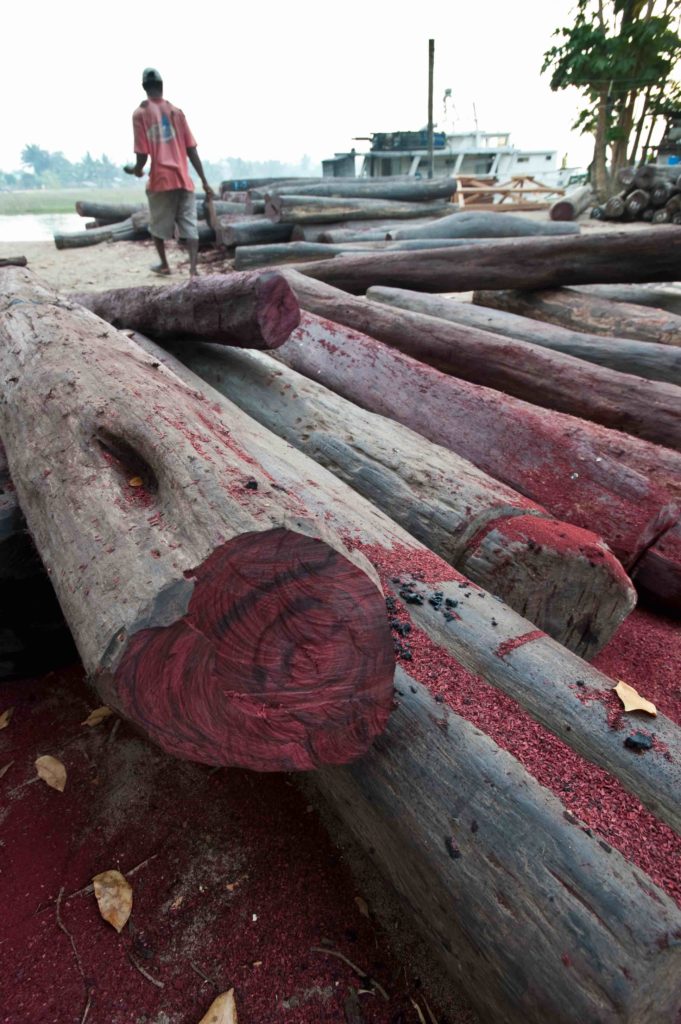
Responding to the crisis, which has pushed rare tree species to the brink of extinction, countries in 2016 moved the vast majority of rosewood species under CITES trade protections.
The trafficking, however, has continued. And when it comes to endangered tree species logged or transported illegally, the shipping routes to the Chinese market often lead through Hong Kong’s container terminals, the world’s fifth-busiest, processing the equivalent of 20 million containers per year.
Several investigative reports have identified the city as an important transit point for illicit wood shipments from Indonesia (2004), Thailand (2010) and Mozambique (2013), to Laos (2014), Cambodia (2015) and Madagascar (2017).
An analysis of seizure records by Coconuts HK identified several more countries from which precious timber has been shipped, or transited, to Hong Kong (see map below).
The city’s port is a “stepping stone” to the mainland, where customs “paperwork can be manipulated,” Guangdong-based logistics firms told EIA investigators, according to a 2014 report.
A TRAFFIC survey of Chinese timber traders published last year, meanwhile, labeled Hong Kong “one of the most important” smuggling ports, where “goods with irregular documentation are unlikely to be inspected” and from which wood could be “smuggled to Guangdong province.”
The preference for routing through Hong Kong really took off after 2013, when mainland authorities began better enforcing CITES trade controls, according to Gehl, who, in a recent phone interview, said the trend appears to have continued.
“Within the past couple of months, we’ve had conversations with some traders in the Chinese mainland who have said that there is still Madagascar rosewood [and] they’re still getting stocks in from Hong Kong. That was confirmed by at least three separate traders. That indicates Hong Kong is still being used,” Gehl said.
Click on the map markers below to view timber shipments linked to Hong Kong (click marker again to deselect).
According to the Customs Department’s own figures, it made 168 log-related seizures between 2013 and the end of 2017, comprising some 1,366 tons of timber.
An analysis of seizure reports by Coconuts HK, places the value of rosewood and red sandalwood confiscated by Hong Kong since 2013 at almost HK$193 million (US$24 million).
Given it’s widely estimated that just 10 percent of trafficked flora and fauna is detected, the amount passing through Hong Kong’s port is likely far greater.
Indeed, the current stockpile held by the AFCD would be significantly larger if not for the work of authorities abroad. In the past five years, major hauls of rosewood headed for Hong Kong have been seized in Panama, Kenya, Mauritius, Sri Lanka, Thailand, and Singapore.
The latter, discovered in March 2014, was the largest rosewood bust in history — some 3,200 tons illegally imported from Madagascar. The case eventually yielded a high-level conviction, with a Singaporean businessman jailed last year.
Singapore received a CITES commendation for the prosecution.
Hong Kong’s AFCD, meanwhile, says it has shared information about its record-breaking seizure with Madagascar, Tanzania, mainland China, and the CITES Secretariat: “For their follow up as appropriate.”
Coconuts HK is awaiting a further response from the government regarding the scale of this year’s seizures and its plans to tackle the trade.
Wildlife-trafficking prosecutions
For more than a year, ADM Capital Foundation (ADMCF) has monitored court hearings and searched records to piece together a snapshot of wildlife trafficking through Hong Kong.
Their findings, yet to be released, paint a picture of a vast trade that blurs the lines between legal imports and illegal trafficking and is often closely tied to organized crime.
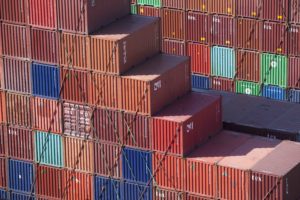
The punishments for trafficking, meanwhile, were found to be “consistently lenient.”
In about 80 percent of the more than 160 cases ADMCF reviewed, prosecutions focused on mules or carriers (mostly those with ivory), rather than networks. Details for convictions about timber seizures were even more scarce.
Information on just three wood-related prosecutions was available for the past three years, despite three rosewood and 40 suspected sandalwood seizures in that time frame.
One example was a HK$4,000 (about US$510) fine meted out for an attempt to traffic 10 tons of red sandalwood from India through Hong Kong in 2015, the year India banned trade in the precious species. The wood, hidden in a 20-foot container marked “flower pots,” was worth HK$6.6 million (about US$841,000), the government estimated.
Another was a case concluded in May that saw a driver, Ho Ka-wai, handed an eight-month jail sentence for “conspiracy to export un-manifested cargo” related to 680 kilograms of red sandalwood.
The 30-year-old was caught late at night in November 2016 delivering the load of timber to a waiting group of men in a speedboat in Tseung Kwan O. His co-conspirators escaped to the waters of mainland China.
On May 30, after a retrial, the judge dismissed two CITES-related charges against Ho, ruling it wasn’t proved that he knew he was carrying endangered species. It’s the type of plausible deniability defense that ADMCF found had been used repeatedly to beat wildlife trafficking accusations.
The circumstances of his arrest fit into a broader trend with red sandalwood, which appears to be shipped into Hong Kong in containers, then smuggled to Guangdong province in small vessels.
To view the dates and locations of suspected red sandalwood seizures, place your cursor over points on the map below.
The pattern suggests Hong Kong is used as a “staging post” for cross-border timber smuggling, said Sam Inglis, Environmental Research Manager at ADMCF.
Authorities foiled more than 22 attempts to spirit sandalwood from Hong Kong’s coast to the mainland between 2013 to 2017. It’s a smuggler’s run that, in at least one case, has been linked to the Sun Yee On triad, members of which were arrested in February after two years of running a cross-border trafficking operation.
“It is possible that these groups are maybe storing the wood locally and breaking it down into smaller batches that are easier to smuggle in cars and boats,” Inglis said.
“Given the volume of wildlife and wood being seized from containers, it’s concerning that we are not seeing the perpetrators behind these organized smuggling networks being prosecuted.”
No easy options
While Hong Kong and other countries have moved to deter ivory traders by publicly destroying confiscated stocks, the approach for seized timber has varied around the world. What constitutes best practice is still debated.
In a move lauded by some environmental groups but called“wasteful” by critics, Belize in 2013 burned some US$450,000 worth of rosewood to send an “unmistakable message” to illegal loggers and traders. Countries including Thailand and Mauritius have repatriated illegal timber to its country of shipment.
Sri Lanka, meanwhile, came under criticism last year when it proposed to auction its stockpile of wood seized on route to Hong Kong. The plan, plagued by corruption allegations, prompted the circulation of falsified CITES permits in China, giving weight to fears that selling seized wood only puts the timber back in the hands of dodgy traders and fuels the illegal trade.
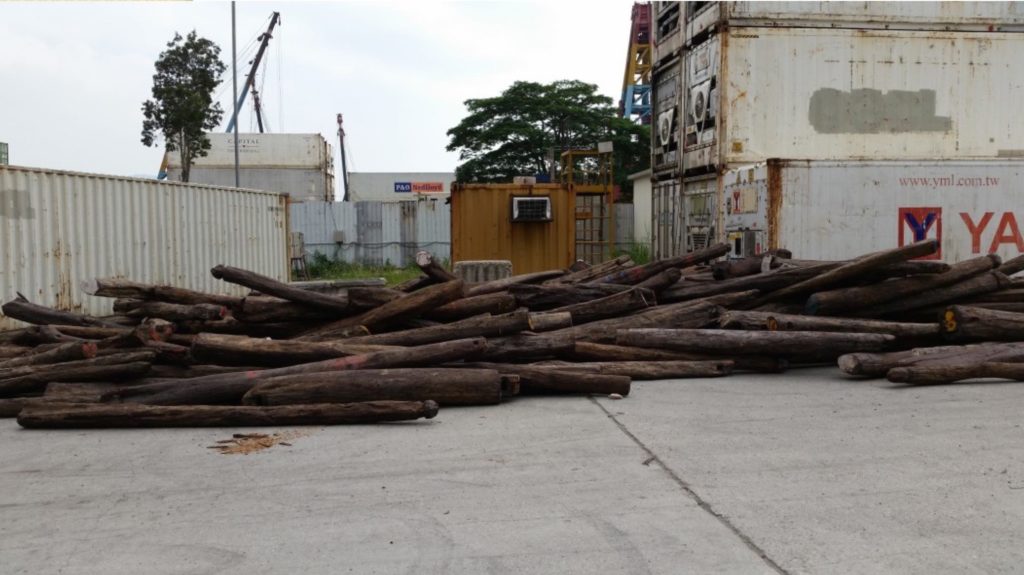
Such are the problems confronting Hong Kong — and several other countries — as they consider what to do with their mounting stockpiles.
The ESAC last December discussed four options advised by the CITES secretariat — returning the timber to its place of origin, auctioning it to raise money for CITES conservation work, using it for non-commercial purposes, or destroying it.
Each poses challenges, particularly with regards to the wood from Madagascar, which is currently pushing to sell its own stockpiles of seized wood to ostensibly fund forest protection, and hopes to receive revenue from the auction of its timber seized overseas.
Given Madagascar’s struggles to curb illegal logging, Hong Kong has been advised against repatriating the wood, and ESAC members are split on the alternatives, according to the minutes of the December meeting.
The preferred option,“non-commercial uses” — such as using the wood for public works, historical building restoration, or educational and cultural purposes — was seized upon by several members, who pressed to use the timber for projects ranging from art pieces to the restoration of a 16-story wooden pagoda in China’s Sichuan province.
That approach, however, is not viable on a large scale. Though at least some of the stockpile will be used to make “non-profit” traditional furniture by university artisans, according to the SCMP, only four percent of the stockpile was judged suitable for non-commercial uses.
Alex Hofford, of WildAid, told Coconuts HK that timber should be “immediately destroyed” to prevent it from re-entering the legal market. The AFCD, meanwhile, sees the wood’s destruction — which would involve dumping it in a landfill, given the cost of incineration — as a “last resort.”
“It’s a very big challenge,” Chen Hin Keong, a timber trade program leader for TRAFFIC, said of the conundrum around the seized stockpiles.
Keong, who is currently working on developing guidelines for timber stockpile management in Eastern Africa, said establishing a set of protocols was “tricky” given all the potential problems, though it was crucial to start having discussions about the topic.
He said, in his view, it would be preferable to make use of the money for long-underfunded conservation projects, though added that even funding and organizing an acceptable auction, one that didn’t benefit unscrupulous traders and fuel demand, would be a costly challenge.
One option, he noted, would be fining major timber traffickers, and using the cash to pay for the process. But that, he said, would be dependent on actually catching them first.
“At the end of the day, someone has to foot the bill,” he said.
